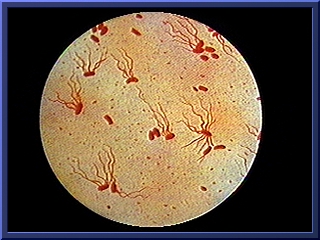Typhoid fever: Difference between revisions
| Line 48: | Line 48: | ||
{{for|a similar disease with a similar name|typhus}} | {{for|a similar disease with a similar name|typhus}} | ||
{{for|a related disease which is caused by a different bacterium|Paratyphoid fever}} | {{for|a related disease which is caused by a different bacterium|Paratyphoid fever}} | ||
==[[Epidemiology]]== | ==[[Epidemiology]]== | ||
[[Image:Typhoid feverI.gif|thumb|right|Locations of typhoid outbreaks worldwide]] | [[Image:Typhoid feverI.gif|thumb|right|Locations of typhoid outbreaks worldwide]] | ||
Revision as of 18:13, 21 August 2012
For patient information click here
| Typhoid fever | |
 | |
|---|---|
| Salmonella typhi bacteria | |
| ICD-10 | A01.0 |
| ICD-9 | 002 |
| DiseasesDB | 27829 |
| MeSH | D014435 |
|
Typhoid fever Microchapters |
|
Diagnosis |
|---|
|
Treatment |
|
Case Studies |
|
Typhoid fever On the Web |
|
American Roentgen Ray Society Images of Typhoid fever |
Editor-In-Chief: C. Michael Gibson, M.S., M.D. [1]
Overview
Historical Perspective
Classification
Pathophysiology
Causes
Differential Diagnosis
Risk Factors
Natural History, Complications and Prognosis
Diagnosis
History and Symptoms | Physical Examination | Laboratory tests | ECG | EEG | Chest X Ray |CT | Echocardiography or Ultrasound |Other imaging studies | Alternative diagnostics
Treatment
Medical therapy | Surgical options | Prevention | Financial costs| Future therapies
|
Typhoid fever Microchapters |
|
Diagnosis |
|---|
|
Treatment |
|
Case Studies |
|
Typhoid fever On the Web |
|
American Roentgen Ray Society Images of Typhoid fever |
Editor-In-Chief: C. Michael Gibson, M.S., M.D. [2]
See also
Epidemiology

With an estimated 16-33 million cases of typhoid annually resulting in 500,000 to 600,000 deaths In endemic areas, the World Health Organisation identifies typhoid as a serious public health problem. Its incidence is highest in children between the ages of 5 and 19 years.[1]
In the United States about 400 cases occur each year, and 75% of these are acquired while traveling internationally. Typhoid fever is still common in the developing world, where it affects about 21.5 million persons each year. Typhoid fever is common in most parts of the world except in industrialized regions such as the United States, Canada, western Europe, Australia, and Japan. Therefore, if you are traveling to the developing world, you should consider taking precautions. Over the past 10 years, travelers from the United States to Asia, Africa, and Latin America have been especially at risk.
Heterozygous advantage
It is thought that cystic fibrosis may have risen to its present levels (1 in 1600 in UK) due to the heterozygous advantage that it confers against typhoid fever. The CFTR protein is present in both the lungs and the intestinal epithelium, and the mutant cystic fibrosis form of the CFTR protein prevents entry of the typhoid bacterium into the body through the intestinal epithelium.
References
- ↑ "Typhoid Fever". World Health Organisation. Retrieved 2007-08-28. Check date values in:
|accessdate=(help)
Further reading
- Gale's Encyclopedia of Medicine, published by Thomas Gale in 1999, ISBN
External links
- "www.netdoctor.co.uk". Article on typhoid fever for travelers. Retrieved 17 december. Unknown parameter
|accessyear=ignored (|access-date=suggested) (help); Check date values in:|accessdate=(help) - United States Center for Disease Control and Prevention Listing
- Harrison, Noel G. (2007). "www.healthsystem.virginia.edu". Historical exhibit on efforts by US Army to control typhoid fever. Unknown parameter
|accessdaymonth=ignored (help); Unknown parameter|accessyear=ignored (|access-date=suggested) (help) - "www.medicalnewstoday.com". Article on typhoid fever and the fall of Athens. Unknown parameter
|accessdaymonth=ignored (help); Unknown parameter|accessyear=ignored (|access-date=suggested) (help) - http://wwwn.cdc.gov/travel/yellowBookCh4-Typhoid.aspx
- http://www.cdc.gov/ncidod/diseases/submenus/sub_typhoid.htm